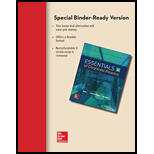
a)
To determine: The expected return on the portfolio of equally weighted Stock A, Stock B, and Stock C.
Introduction:
Expected return refers to the return that the investors expect on a risky investment in the future.
Portfolio expected return refers to the return that the investors expect on a portfolio of investments.
a)
Answer to Problem 9QP
The expected return on the portfolio is 11.67 percent.
Explanation of Solution
Given information:
The
All the above stocks carry equal weight in the portfolio.
The formula to calculate the expected return of the portfolio in each state of the economy:
The formula to calculate the portfolio expected return:
Where,
E(RP) refers to the expected return on a portfolio
“x1 to xn” refers to the probability of each asset from 1 to “n” in the portfolio
“E(R1) to E(Rn) ” refers to the expected
Compute the expected return of the portfolio of the boom economy:
R1 refers to the rate of returns of Stock A. R2 refers to the rate of returns of Stock B.
R3 refers to the rate of returns of Stock C.
Hence, the expected return of the boom economy is 0.17 percent.
Compute the expected return of the portfolio of the bust economy:
Hence, the expected return of the bust economy is 0.0367 percent.
Compute the portfolio expected return:
Hence, the expected return on the portfolio is 0.1167 or 11.67 percent.
b)
To determine: The variance of the portfolio
Introduction:
Portfolio variance refers to the average difference of squared deviations of the actual data from the mean or expected returns.
b)
Answer to Problem 9QP
The variance of the portfolio is 0.014292 percent.
Explanation of Solution
Given information:
The rate of return of Stock A is 15 percent, Stock B is 2 percent, and Stock C is 34 percent when the economy is in booming condition. The rate of return of Stock A is 3 percent, Stock B is 16 percent, and Stock C is −8 percent when the economy is in busting condition. The probability of having a boom is 60 percent, and the probability of having a bust cycle is 40 percent.
The formula to calculate the portfolio expected return:
Where,
E(RP) refers to the expected return on a portfolio
“x1 to xn” refers to the weight of each asset from 1 to “n” in the portfolio
“E(R1) to E(Rn) ” refers to the expected return on each asset from 1 to “n” in the portfolio
The formula to calculate the variance of the portfolio:
Compute the portfolio return during a boom:
The return on Stock A is 15 percent “RStock A”, the return on Stock B is 2 percent “RStock B”, and the return on Stock C is 34 percent “RStock C” when there is a boom cycle. It is given that the weight of Stock A is 20 percent (xStock A), the weight of Stock B is 20 percent (xStock B), and the weight of Stock C is 60 percent (xStock C).
Hence, the return on the portfolio during a boom is 0.2380 or 23.80 percent.
Compute the portfolio return during a bust cycle:
The return on Stock A is 3 percent “RStock A”, the return on Stock B is 16 percent “RStock B”, and the return on Stock C is (−8 percent) “RStock C” when there is a bust cycle. It is given that the weight of Stock A is 20 percent (xStock A), the weight of Stock B is 20 percent (xStock B), and the weight of Stock C is 60 percent (xStock C).
Hence, the return on the portfolio during a bust cycle is −0.01percent or −1 percent.
Compute the portfolio expected return:
Hence, the expected return on the portfolio is 0.1388 or 13.88 percent.
Compute the variance:
The probability of having a boom is 60 percent, and the probability of having a bust cycle is 40 percent.
Hence, the variance of the portfolio is 0.014292.
Want to see more full solutions like this?
Chapter 11 Solutions
Loose Leaf for Essentials of Corporate Finance
- You have observed the following returns over time: Assume that the risk-free rate is 6% and the market risk premium is 5%. What are the betas of Stocks X and Y? What are the required rates of return on Stocks X and Y? What is the required rate of return on a portfolio consisting of 80% of Stock X and 20% of Stock Y?arrow_forwardAn analyst has modeled the stock of a company using the Fama-French three-factor model. The market return is 10%, the return on the SMB portfolio (rSMB) is 3.2%, and the return on the HML portfolio (rHML) is 4.8%. If ai = 0, bi = 1.2, ci = 20.4, and di = 1.3, what is the stock’s predicted return?arrow_forwardThe standard deviation of stock returns for Stock A is 40%. The standard deviation of the market return is 20%. If the correlation between Stock A and the market is 0.70, then what is Stock A’s beta?arrow_forward
 Intermediate Financial Management (MindTap Course...FinanceISBN:9781337395083Author:Eugene F. Brigham, Phillip R. DavesPublisher:Cengage Learning
Intermediate Financial Management (MindTap Course...FinanceISBN:9781337395083Author:Eugene F. Brigham, Phillip R. DavesPublisher:Cengage Learning




